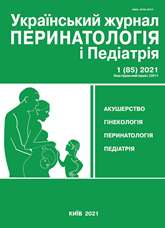Congenital diaphragmatic hernia: clinical cases among post2neonatal age infants
DOI:
https://doi.org/10.15574/PP.2021.85.100Keywords:
congenital diaphragmatic hernia, InfancyAbstract
Congenital diaphragmatic hernia is a defect of diaphragm development which in the majority of cases is associated with penetration of the abdominal organs into the chest.
Purpose is to draw attention of pediatricians, general practitioners and family doctors, pediatric surgeons to the issue of timely diagnostics of congenital diaphragmatic hernia since its clinical signs are manifested in patients of a post-neonatal age.
Clinical cases. The first review demonstrates a clinical case of a right false congenital diaphragmatic hernia of 6-month child with acute onset of the disease manifested by combination of respiratory disorders and pathological intestinal symptoms, visualization of intestinal loops in the right side of the chest. The second clinical case describes left false congenital diaphragmatic hernia of a 10-month child with subacute onset of the disease, prevailing pathological respiratory symptoms and visualization of the stomach in the left side of the chest. Due to timely diagnostic examination and surgery performed both patients were discharged home in a satisfactory condition.
Conclusions. In spite of more favourable course of congenital diaphragmatic hernia in children older than 1 month of age, its development can be of a fulminant character and associated with danger for life. It stipulates the necessity to carry out an appropriate differential-diagnostic complex for all the infants with acute or chronic respiratory disorders and pathological intestinal symptoms including a competent interpretation of the results obtained after plan and contrast radiography of the thoracic and abdominal organs.
The research was carried out in accordance with the principles of the Helsinki Declaration. The informed consent of the patient was obtained for conducting the studies.
No conflict of interest was declared by the authors.
References
Baerg J, Kanthimathinathan V, Gollin G. (2012). Late-presenting congenital diaphragmatic hernia: diagnostic pitfalls and outcome. (2012). Hernia. 16(4): 461-466. https://doi.org/10.1007/s10029-012-0906-5; PMid:22395789
Chandrasekharan PK, Rawat M, Madappa R, Rothstein DH, Lakshminrusimha S. (2017). Congenital Diaphragmatic hernia - a review. Matern Health Neonatol Perinatol. 3: 6. https://doi.org/10.1186/s40748-017-0045-1; PMid:28331629 PMCid:PMC5356475
Dumpa V, Chandrasekharan P. (2020). Congenital Diaphragmatic Hernia. In: StatPearls. Treasure Island (FL): StatPearls Publishing. URL: https://www.ncbi.nlm.nih.gov/books/NBK556076/.
Gorbatyuk OM, Makedonsky IA, Kurilo HV. (2019). Modern strategies of the diagnostics, surgical correction and prevention of congenital anomalies in newborns. Neonatology, Surgery and Perinatal Medicine. 4 (34): 88-97. https://doi.org/10.24061/2413-4260.IX.4.34.2019.7
Longoni M, Pober BR, High FA. (2020). Congenital Diaphragmatic Hernia Overview. In ed Adam MP, Ardinger HH, Pagon RA et al. GeneReviews®. Seattle (WA): University of Washington, Seattle: 1993 2021. URL: https://www.ncbi.nlm.nih.gov/books/NBK1359/.
Mai CT, Isenburg JL, Canfield MA, Meyer RE, Correa A, Alverson CJ, Lupo PJ, Riehle Colarusso T, Cho SJ, Aggarwal D, Kirby RS. (2019). National population-based estimates for major birth defects, 2010-2014. Birth Defects Research. 111 (18): 1420-1435. https://doi.org/10.1002/bdr2.1589; PMid:31580536 PMCid:PMC7203968
Puligandla PS, Skarsgard ED, Offringa M, Adatia I, Baird R, Bailey JAM, Brindle M, Chiu P, Cogswell A, Dakshinamurti S, Flageole H, Keijzer R, McMillan D, Oluyomi Obi T, Pennaforte T, Perreault T, Piedboeuf B, Riley SP, Ryan G, Synnes A, Traynor M, The Canadian Congenital Diaphragmatic Hernia Collaborative. (2018). Diagnosis and management of congenital diaphragmatic hernia: a clinical practice guideline. CMAJ. 190 (4): 103-112. https://doi.org/10.1503/cmaj.170206; PMid:29378870 PMCid:PMC5790558
Salocha AF, Borys OYa, Ivanochko RV. (2020). Is congenital diaphragmatic hernia a pathology of the neonatal period only? Paediatric Surgery. Ukraine. 2 (67): 91-95. https://doi.org/10.15574/PS.2020.67.91
Snoek KG, Reiss IK, Greenough A, Capolupo I, Urlesberger B, Wessel L, Storme L, Deprest J, Schaible T, van Heijst A, Tibboel D, CDH EURO Consortium. (2016). Standardized Postnatal Management of Infants with Congenital Diaphragmatic Hernia in Europe: The CDH EURO Consortium Consensus - 2015 Update. Neonatology. 110 (1): 66-74. https://doi.org/10.1159/000444210; PMid:27077664
Downloads
Published
Issue
Section
License
The policy of the Journal “Ukrainian Journal of Perinatology and Pediatrics” is compatible with the vast majority of funders' of open access and self-archiving policies. The journal provides immediate open access route being convinced that everyone – not only scientists - can benefit from research results, and publishes articles exclusively under open access distribution, with a Creative Commons Attribution-Noncommercial 4.0 international license(СС BY-NC).
Authors transfer the copyright to the Journal “MODERN PEDIATRICS. UKRAINE” when the manuscript is accepted for publication. Authors declare that this manuscript has not been published nor is under simultaneous consideration for publication elsewhere. After publication, the articles become freely available on-line to the public.
Readers have the right to use, distribute, and reproduce articles in any medium, provided the articles and the journal are properly cited.
The use of published materials for commercial purposes is strongly prohibited.

